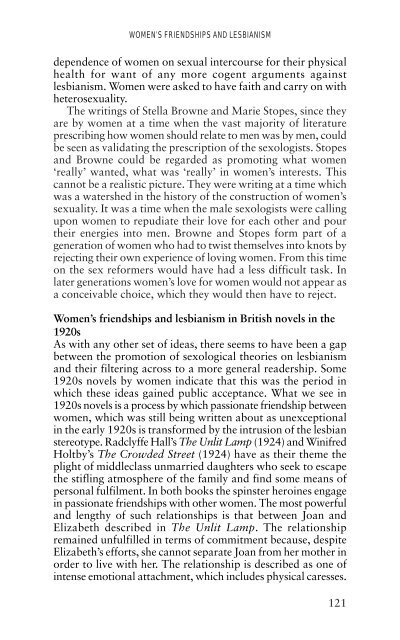The Spinster and Her Enemies - Feminish
The Spinster and Her Enemies - Feminish
The Spinster and Her Enemies - Feminish
You also want an ePaper? Increase the reach of your titles
YUMPU automatically turns print PDFs into web optimized ePapers that Google loves.
WOMEN’S FRIENDSHIPS AND LESBIANISM<br />
dependence of women on sexual intercourse for their physical<br />
health for want of any more cogent arguments against<br />
lesbianism. Women were asked to have faith <strong>and</strong> carry on with<br />
heterosexuality.<br />
<strong>The</strong> writings of Stella Browne <strong>and</strong> Marie Stopes, since they<br />
are by women at a time when the vast majority of literature<br />
prescribing how women should relate to men was by men, could<br />
be seen as validating the prescription of the sexologists. Stopes<br />
<strong>and</strong> Browne could be regarded as promoting what women<br />
‘really’ wanted, what was ‘really’ in women’s interests. This<br />
cannot be a realistic picture. <strong>The</strong>y were writing at a time which<br />
was a watershed in the history of the construction of women’s<br />
sexuality. It was a time when the male sexologists were calling<br />
upon women to repudiate their love for each other <strong>and</strong> pour<br />
their energies into men. Browne <strong>and</strong> Stopes form part of a<br />
generation of women who had to twist themselves into knots by<br />
rejecting their own experience of loving women. From this time<br />
on the sex reformers would have had a less difficult task. In<br />
later generations women’s love for women would not appear as<br />
a conceivable choice, which they would then have to reject.<br />
Women’s friendships <strong>and</strong> lesbianism in British novels in the<br />
1920s<br />
As with any other set of ideas, there seems to have been a gap<br />
between the promotion of sexological theories on lesbianism<br />
<strong>and</strong> their filtering across to a more general readership. Some<br />
1920s novels by women indicate that this was the period in<br />
which these ideas gained public acceptance. What we see in<br />
1920s novels is a process by which passionate friendship between<br />
women, which was still being written about as unexceptional<br />
in the early 1920s is transformed by the intrusion of the lesbian<br />
stereotype. Radclyffe Hall’s <strong>The</strong> Unlit Lamp (1924) <strong>and</strong> Winifred<br />
Holtby’s <strong>The</strong> Crowded Street (1924) have as their theme the<br />
plight of middleclass unmarried daughters who seek to escape<br />
the stifling atmosphere of the family <strong>and</strong> find some means of<br />
personal fulfilment. In both books the spinster heroines engage<br />
in passionate friendships with other women. <strong>The</strong> most powerful<br />
<strong>and</strong> lengthy of such relationships is that between Joan <strong>and</strong><br />
Elizabeth described in <strong>The</strong> Unlit Lamp. <strong>The</strong> relationship<br />
remained unfulfilled in terms of commitment because, despite<br />
Elizabeth’s efforts, she cannot separate Joan from her mother in<br />
order to live with her. <strong>The</strong> relationship is described as one of<br />
intense emotional attachment, which includes physical caresses.<br />
121

















